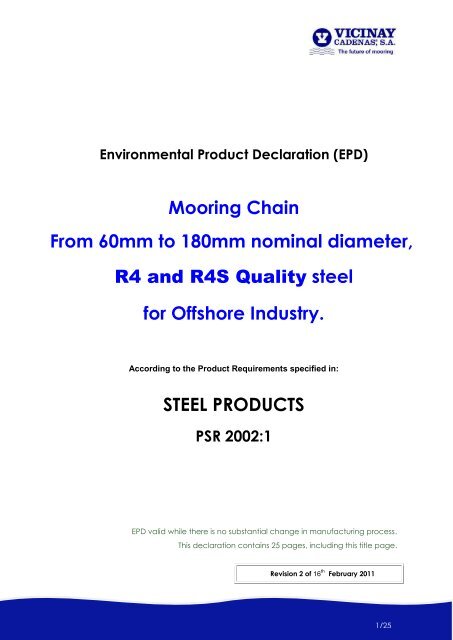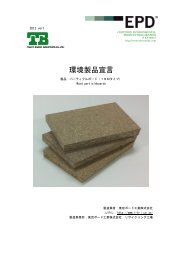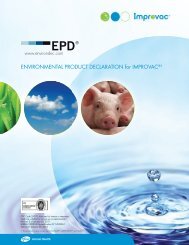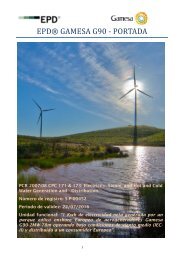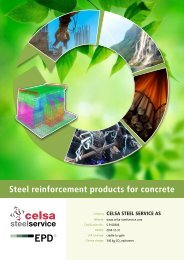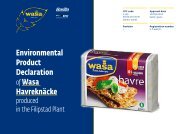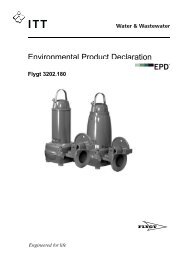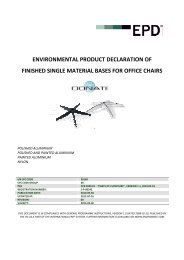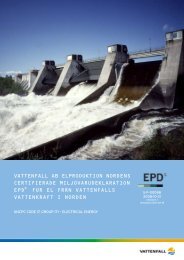PLANTILLA PARA EPD DE PRODUCTOS DE ACERO
PLANTILLA PARA EPD DE PRODUCTOS DE ACERO
PLANTILLA PARA EPD DE PRODUCTOS DE ACERO
Create successful ePaper yourself
Turn your PDF publications into a flip-book with our unique Google optimized e-Paper software.
CHAIN PRODUCTIONThe organization’s bussines is the Design, Manufacturing and Supply of hightechnology chains for the naval sector and the offshore industry. The chains producedhave diameters anywhere between 60mm and 185mm (although links of up to 210mmare possible) and are made continuously. There are no known industrial restrictions interms of length and/or weight.Vicinay Cadenas has a forging plant located inGaldames, also in the North of Spain, whichproduces accessories (standard or custom shacklesdesigned to meet the needs of the client) for thesame naval and offshore sectors. These accessoriesare expressly excluded from the scope of thisEnvironmental Product Declaration.The company produces products in different qualities of steel, ranging from R3 to R5(up to 1000 MPa). We are currently developing a new steel quality (to be called R6),which will have a tensile strength value of 1200 MPa.Vicinay Cadenas S.A.’s Health and Safety, Quality and Environmental policies are keptup to date and are available for inspection by any interested party. These policiesguarantee the fulfillment of both the client and the legal and environmentalrequirements applicable to its processes. What follows is a brief overview of thecertifications and approvals which have been awarded to the company:CERTIFICATIONSABS QUALITY PROGRAMAPI 2F -Q1 8th ed.DnV ISO 9001:2008DnV ISO 14001:2004Dnv OHSAS 18001:2007LRQA ISO 9001:2008APPROVALSABS CHAIN & ACCESSORIES APPROVALBV CHAIN & ACCESSORIES APPROVALDNV CHAIN & ACCESSORIES APPROVALGERMANISCHER LLOYD APPROVALLR CHAIN & ACCESSORIES APPROVALRINA CHAIN & ACCESSORIES APPROVALLRQA ISO 14001:2004LRQA OHSAS 18001:20075/25
Each of the processes from the buying of the raw material to the sale of the finalproduct are subject to internal procedures which are the object of annual revision bothby Vicinay Cadenas and External Auditors.The steel specification gives detailed information regarding the chemical composition,tests for quality control, delivery method (dimensional requirements and packaging) andmechanical characteristics. There are no relevant environmental implications in thedesign of the product because we are using only one material, namely steel alloy.3.2 Recycling Declaration.All of the steel used in the manufacturing of the chain is obtained from recycledmaterial.The products designed and made by Vicinay Cadenas are prepared to be able towithstand stringent technical requirements and adverse environmental conditions duringtheir calculated useful life-span of 20 years. When the useful life-span has concludedthe chain is then recycled.There is currently no environmental legislation, in the countries in which we operate,known to Vicinay Cadenas at the present time, to which the final product is subject.7/25
4. METHODOLOGY OF LIFE CYCLE ASSESSMENT4.1 Definition of the supply chain. Process and system boundary map.The diagram below shows the life-cycle of the product which is the subject of thisdeclaration.RAW MATERIALROUND BARACQUISITION9. HEATTREATMENTTRANSPORT TO VCSA1. STORAGE2. CUTTING3. PREHEATING4. BENDING5. FLASH BUTT WELDING10. PROOF AND BREAKLOAD TESTING11. SHOT BLASTING12. NDT INSPECTING6. TRIMMING7. PRESSING8. SHOT BLASTING13. I<strong>DE</strong>NTIFICATIONAND STORAGE14. TRANSFERRING TOCLIENTVICINAY CA<strong>DE</strong>NAS INDUSTRIAL PROCESSDISTRIBUTIONEND OF LIFE2 Life-cycle diagram for a mooring chain.This diagram shows all of the phases of the life-cycle, from the acquisition of the rawmaterial from the supplier up to the final recycling where the product is returned to itsinitial state as scrap metal. The life-cycle defined supposes a closed loop in which thescrap metal obtained from a recycled chain is used in the manufacturing of a new steelproduct.8/25
The system boundaries, according to PSR 2002:1 “Steel Products” document,determine which processes are included in the present declaration. In this document weconsider each of the processes to which the chain is submitted from the collection of theraw material to the end of the product’s working life (from the womb to the tomb).However, the scope of the study we have made estimates for those external phaseswhich warrant such attention.Chain manufacturing process1. Steel maker supplier:The life-cycle begins with the production of the steel bars at the steel manufacturer’splants, which are located in Basauri, Azkoitia and Reinosa, northern Spain. At theseplants, starting from selected scrap metals the steel alloy, through a process of electricsteel making plant, is produced to the “recipe” specified by Vicinay Cadenas. Finally thesteel bar is packaged and transported by (diesel) lorries, belonging to the steelmanufacturer, to the chain manufacturing plant in Bilbao.2. Manufacture:When the steel bars arrive at the plant these bars are classified and stored in metallicpallets in the reception area. When needed they are taken, by crane (electricconsumption) to a conveyor system which takes the steel bars to the cutting process,where each bar is cut to the required length.Any left-overs after the cutting process, which are minimized inpurchase order, usually between 2% and 5% of the total massare managed as revalued waste (scrap metal).After cutting, the “lengths” are transported to the manufacturingworkshop, where they undergo five operations, in a merry-goroundconfiguration (carousel): 1. Pre-heating (in the case ofthe large chain this heating takes place in an oven powered bynatural gas. In the case of the light chain it takes place in anelectric oven).9/25
2. Bending (electricity and scale). 3. Welding (electricity and scale). 4. Trimming(electricity and revalued waste) and 5. Pressing (electricity and scale). Connecting, oneby one, each link until the required length is obtained.After leaving the carousel, the link’s surface is cleaned using a spherical, metallic shotblastingprocess (non hazardous waste) which makes non-destructive inspection easier.These cleaning machines have a system to separate the used shot from dust makingnon hazardous waste segregation and reuse easier.After non-destructive inspection any material that does not conform to quality standardsis painted blue and is cut and removed from the chain. This cut material is classed asrevalued waste.After having undergone these processes the chain then passes on to the heat treatmentphase. This is done so that the material’s base structure is regenerated around thewelded section. This treatment consists of double quenching followed by tempering.Between each step the chain is cooled by immersion in a closed water circuit which isnot emptied externally.After heat treatment the chain istested to verify its resistance totraction using proof loads rigorouslydetermined according the chain’sdimensions and quality. 100% ofthe links are tested in a tractionmachine (electricity) after which theelongation of the link is tested. Thisis done to make sure that the loadand dimensions are in accordance with the specifications.After a second shot-blasting cleaning operation, the chain is once again inspected todetermine if there are any defects. This operation starts with a visual inspection of eachand every link. After identifying any possible flaws (metallic deposits which were noteliminated during shot-blast cleaning) on the surface of the link these defects areremoved by manual soft grinding.10/25
In those cases in which first-hand data for specific processes and/or materials was notavailable theoretical calculations, estimations or the use of data from internationallyrenowned sources (ECOINVENT, BUWAL, ETH, etc) has been used. Special use hasbeen made of the Ecoinvent database, due to its content of more tan 4000 life-cycleinventories and its frequency of actualization.5. ENVIRONMENTAL BEHAVIOUR OF THE PRODUCT IN THE LIFE-CYCLE5.1 Methodology for Calculating and Exclusion criteriaRECYCLEDSTEEL100%In the following section we provide the environmentalbehaviour information according to the document withreference PSR 2002:1 for steel products, includingthe manufacturing process, delivery, use and end-oflife, for Vicinay Cadenas light and heavy chain in R4and R4S qualities.All of the values reported in the following point refer tothe functional unit of this study (1.000Kg of chain from 60mm to 180mm in diameter andR4 and R4S quality).The data is taken from the consumption control tables created by Vicinay Cadenasusing information from natural gas, electricity and water bills from the utility companies,the weight control from a properly calibrated scale and delivery notes of the diversesupplies reported according to the Environmental Management System certifiedaccording to ISO 14001:2004 procedure “Measuring and Follow-up”.14/25
5.2 Environmental Behavior in the Raw Material Collection and Steel productionPhase.In this phase we include the environmental impacts generated by the steel manufacturerin the collection of its raw materials (scrap metal) and the production of the steel bars.We also include transportation of material from the steel making plant to VicinayCadenas.The details presented below show the impact in this phase according to the CML 2001methodology:IMPACT CATEGORYUNITTOTAL/1,000 KgChainGlobal Warming Potential (GWP) kg CO2 1,214.53Acidification (AP) mol H + 528.90Ozone Depletion Potential (ODP) kg CFC-11 0.0003Photochemical Ozone Creation Potential(POCP)kg C2H4 0.79Eutrophication (EP) g O2/g 26,789.7715/25
5.3 Environmental Behavior in the Production Phase5.3.1 Use of ResourcesThe consumption of resources in the manufacturing process is divided intotwo distinct groups depending on whether they contain or do not containan energy component:RESOURCES WITH ENERGY CONTENTRENEWABLEElectricity from renewable sourcesNO RENEWABLEElectricity from non-renewable sources, Diesel and NaturalGasMJ/1.000 kgChain308.4530,759.05Amongst the resources which contain energy the electricity used is taken fromthe Spanish National Electricity Grid. The supplying company provides thefollowing “mix”:ELECTRICAL CONSUMPTION1.490,08 MJ/1.000 Kg ChainNon-renewable 79.3 % 1.181,63 MJ/1.000 Kg ChainHigh-efficiency co-generation 1.7 % 25.33 MJCo-generation 8.1 % 146.03 MJNatural Gas (combined cycle) 30.1 % 448.51 MJCoal 15.9 % 236.92 MJFuel/Gas 3.3 % 49.17 MJNuclear 19.3 % 287.59 MJOthers 0.9 % 13.41 MJRenewable 20.7 % 308.5 MJ/1,000 Kg16/25
There is no energy reuse in the chain manufacturing plant. All energy comesfrom the national grid.The consumption of resources with no energy component is as follows:RESOURCES WITHOUT ENERGY CONTENTRENEWABLESteel.NO RENEWABLECopper, cutting fluids, lubricants and paints.kg/1,000 kgChain1,052.38267.36WATER 1.35We have considered steel as a renewable material due to the high proportion ofsteel recycling on a world-wide scale.5.3.2 Emissions to Air, Water, and Earth.The following indicators reflect the potential environmental impactcaused by the chain manufacturing process. We again make useof the CML 2001 methodology:IMPACT CATEGORYUNITTOTAL/1,000 KgChainGlobal Warming Potential (GWP) kg CO 2 970.7Acidification (AP) mol H + 271.40Ozone Depletion Potential (ODP) kg CFC-11 0.0003Photochemical Ozone Creation Potential (POCP) kg C 2 H 4 0.37Eutrophication (EP) g O 2/g 24,684.43List of environmental impact indicators.17/25
Note: The units selected as indicators for environmental impact and the conversionfactors used are those prescribed in “Appendix A of the MSR 1999:2” (Rev. 1.1dated 2005/9/25) and those chosen in the CML 2001 methodology forcalculating environmental impact. This methodology is fully developed and usedat European level due to the reliability of its data and its scientific bases whichare upheld in the methodology and procedures established by Guinèe et al.(2001).In the table below we provide details of the emissions to both air and water of thesubstances required. All data provided has been ratified by Authorized ControlOrganisms (A.C.O) which are in turn controlled by the corresponding administration, inthis case The Basque Regional Government.Emissions to airg/1,000 kgChainEmissionsto waterg/1,000 kgChainSO2 5,834.06 Cr 14.19NOx 3,060.88 Ni 28.00Solid particles 1,311.99 Zn 10.94Cd 0.03 Lubricants 180.04Cr1.85Materials insuspension 550.08Hg 0.15 Total: 783.25Ni 2.94Pb 28.94Zn 106.46Total: 10,347.31Emissions to air and water caused by the manufacturing process.18/25
5.3.3 Residues.The waste generated during the chain manufacturing process is divided intohazardous and non-hazardous, according to Spanish and European law.Hazardous waste undergoes a special external treatment by a companyauthorized by the Regional Government. The vast majority of non-hazardouswaste undergoes recycling due to being, in the main part, metallic revaluedwaste which can be reused.Production process wastekg/1000 kgChainHazardous waste 0.29Used oils (EWC 13 02 06) 0.02Hydrocarbon impregnated materials (EWC 15 02 03)
Revalued Wastekg/1000 kgChainScrap metal 19.31Total: 19.315. 4 Environmental Behavior in the Delivery Phase.The results of the environmental impact in the Delivery Phase are shown below:IMPACT CATEGORYUNITTOTAL/1,000 KGchainGlobal Warming Potential(GWP)kg CO 2 eq. 213.14Acidification (AP) mol H+ 146.17Ozone Depletion Potential(ODP)Photochemical Ozone CreationPotential (POCP)kg CFC-11 eq. 0.0003kg ethylene eq. 0.15Human generated toxicity kg 1.4-DCB eq. 136.92Ecotoxicity kg 1.4-DCB eq. 18,808.91Eutrophication (EP) g O 2/g 21,027.81Depletion of abiotic resources kg Antimony eq. 1.42Note: The units selected as indicators for environmental impact and the conversionfactors used are those prescribed in “Appendix A of the MSR 1999:2” (Rev. 1.1dated 2005/9/25) and those chosen in the CML 2001 methodology forcalculating environmental impact. This methodology is fully developed and usedat European level due to the reliability of its data and its scientific bases whichare upheld in the methodology and procedures established by Guinèe et al.(2001).20/25
5.5 Environmental Behavior during the Operational Life of the ChainWithin the operational phase of the life-cycle we have only taken into accounttransportation of the chain by vessel (the only possible method of transport due tovolume and weight) to the place in which the chain will be used by the client. Toestimate the distance that the vessel will travel we have based our evaluation on otherorders delivered in the year 2008, and then an estimation of the average distance foreach journey. Finally, calculating the weighted mean total for the year:NumberofJourneysDestinationEstimateddistance(km)Tons.Journeys xDistance xTons.Tons/Kilometreexpressed asfunctionalunits.5 Gulf of Mexico 8,300 3,853 127,919,6007 Norway 3,000 332 5,976,0002 West Africa 4,500 8,581 193,072,50019,8844 Europa - Russia 1,500 4,728 21,276,000The delivery method is using transoceanic freight ship.The environmental impact is measured according tothe number of tons of chain transported and thenumber of kilometers travelled. Within this indicator wetake into account the production and maintenance ofthe vessel, the port and the average consumption offuels and resources (Ecoinvent Data 2.0: transport,transoceanic freight ship, OCE, [tkm] (#1968)).21/25
5. 6 Environmental Behavior at the End of Working Life PhaseThe products designed and produced by Vicinay Cadenas are made to enduredemanding technological requirements and adverse environmental conditions. Theestimated useful life of the product is 20 years. After this time has elapsed we considerthat it can then be fully recycled.REVALUEDSTEEL100%Within the framework of the current study we estimate therecycling of this chain will prevent the emission to air of1,231 Kg eq CO2 and will reduce the necessaryconsumption of 1,050.2 kg of raw materials by which wecreate a positive environmental impact. The recyclingprocess is made up of recovering the chain at the end of itsuseful life giving rise to revalued waste which, whencorrectly selected, can be used to create new steel products for the market, there bytaking advantage of the original steel and beginning, once again, the life-cycle.22/25
6. OTHER COMPANY INFORMATION.Vicinay Cadenas has, for a long time, beenimplementing in its industrial activity improvementsand innovation in its manufacturing process whichhave contributed a more efficient prevention ofpollution and an increased respect for ourenvironment.The new qualities of steel designed specifically for chains and accessories, with anoptimal behavior with respect to erosion and corrosion, have contributed to theelimination of bitumen based finishing paints which were never considered favorable tothe environment.Today, continuing with a highly creative policy of R+D+i in collaboration with prestigioussteel manufacturers, the University of the Basque Country and other TechnologicalCenters, we continue to introduce new materials having chemical compounds anddesign features which push forward the frontiers for mooring the Offshore Industry. Theadvanced operating features of these new materials also reduce the quantity of naturalresources because of a better fatigue endurance and the systematic reduction in theweight of the chain.Vicinay Cadenas stopped using, many years ago, the least favorable energy sources(heavy fuel oil) in its heating and heat treatment processes, moving to natural gaswhich is more eco-friendly in terms of emissions. These fuels are gradually beingreplaced by energy sources which contain a higher degree of renovation which allowsus to use electrical induction techniques in heating processes.Replacing aromatic paints used in the non-destructive inspection phase (paint forcontrast in magnetic particle inspection) with water based paints and the introduction ofspecifically designed eco-friendly products, where possible, has been a constantconcern in the day-to-day running of the company.23/25
The location of the chain making plant, in a metropolitan area, has led us to be morerespectful concerning the way in which the industrial landscape is surrounded byresidential areas. This concern has led us to be more sensitive to the way in which wemay be of a nuisance to our neighbors taking into account, in production scheduling,the minimization of noise and vibrations, the time at which loading and unloading takesplace. All with the aim of improving the responsibility and the image of the company.Another constant factor, firstly for economicmanagement reasons, and then because of anincreased sensitivity for the environment, has beenthe management of energy and resourceconsumption in which we are continuously lookingfor optimization strategies and ways to helpsustainability.Interchanging best practices with other companies which have a proven track-record ofbeing eco-friendly has allowed Vicinay Cadenas to become a member of Izaite, theAssociation of Basque Companies for Sustainability, a group which is fully committed toSustainable Development and Corporate Social Responsibility (www.izaite.net).Vicinay Cadenas clearly expresses in its “Mission, Vision, Values and Policy” statementits vocation of being a local company with a world-wide projection. Developing itsalliances and agreements with local partners. Thus, clearly benefiting from reducedtransportation both to and from the factory.Vicinay Cadenas has also, voluntarily, subscribed to The United Nations GlobalCompact, being principle 7 the one which binds the company to be proactive in itsapproach to environmental challenges.24/25
7. CERTIFYING ORGANISATION INFORMATIONCritical review of the Life-cycle Assessment relating todocument PSR 2002:1 Steel Products carried out by:INGURUMENAREN KI<strong>DE</strong>AK INGENIERIA.Avenida San Bartolomé 1º 1ºA, 48903 Barakaldo-Vizcaya.Gorka Benito Alonso. ik@ik-ingenieria.comIndependent verification of the declaration and data in accordance with ISO 14025: internalexternal certification processExternal verifierSerumano, S.L. / Mr. Anxo Mourelle Alvarez / Enrique Mariñas 36, 4ª – 15009 A Coruña –Spain / anxo_mourelle@serumano.comCERTIFICATION ORGANISATIONThe International <strong>EPD</strong> ® systemCERTIFICATION VALIDITY PERIODREGISTRY NUMBER2014-02-24 S-P-00185This <strong>EPD</strong> belongs to R4 and R4S quality chains, treating them as a uniquegroup because of being similar products, in all its dimensions: from 60mm to180mm (light and heavy chain) used in mooring lines for Offshore Industry.Data referring to the same category (mooring lines) but with differentdiameters or qualities can not be compared.Additional information referring to this <strong>EPD</strong> can be found at the web site of thesystem operator: http://www.environdec.com.---------------- END OF THE <strong>DE</strong>CLARATION --------------------Tomás López Alonso - Director of Integrated Management SystemsBilbao on the 03 rd of December, 200925/25


